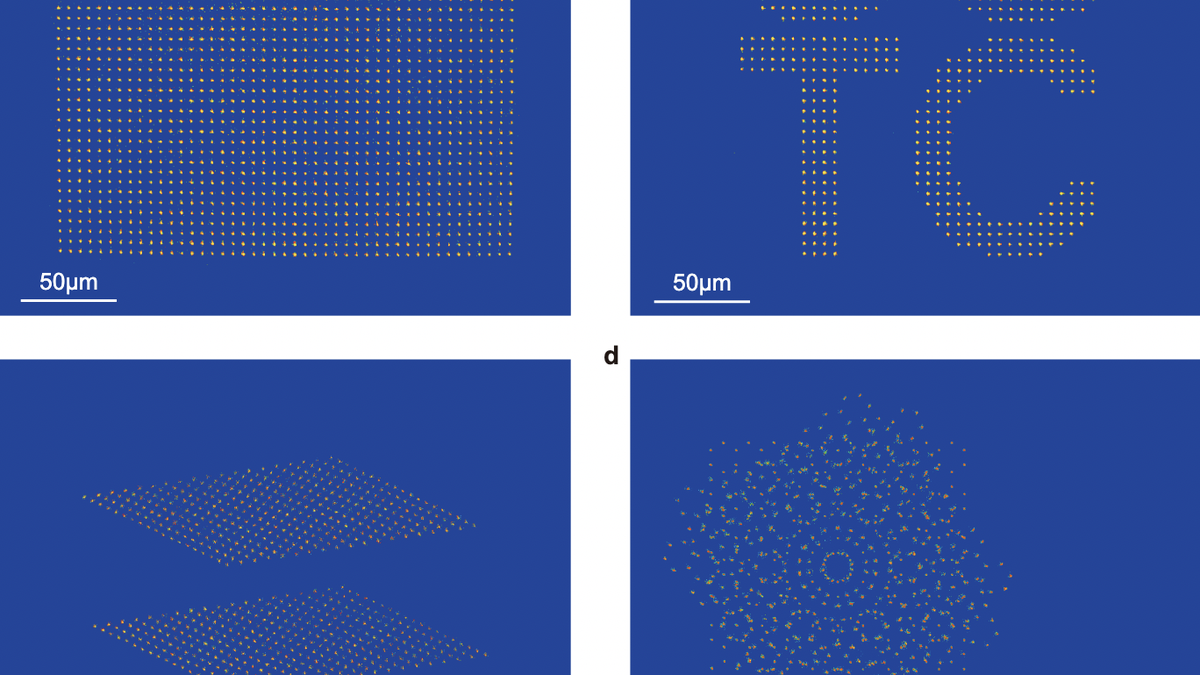Clockwise from top-left: nearly defect-free 2D square array with 2,024 atoms; 2D pattern of the letters ‘USTC’ with 723 atoms; trilayer cuboid array with 1,077 atoms; trilayer twisted graphene structure with 752 atoms.
| Photo Credit: arxiv:2412.14647
Quantum computing holds the promise to revolutionise science and technology by solving problems currently beyond the limits of classical computers. A critical step to building practical quantum computers is assembling large arrays of qubits — or quantum bits — with no defects.
On August 8, researchers from China reported significant progress on this front by developing a way to rapidly and reliably create large arrays of neutral atoms. Their findings were published in Physical Review Letters.
Neutral atoms, like rubidium atoms, can be trapped and controlled by small laser beams called optical tweezers. These atoms serve as qubits for quantum computing and simulations. Creating arrays with thousands of atoms positioned precisely is vital because it allows for complex quantum operations and error correction. However, placing atoms perfectly in large arrays is a major challenge because atoms are loaded randomly and often with missing sites.
Traditionally, strategies to assemble defect-free arrays involve moving atoms one by one or row by row using movable optical tweezers. This process takes longer with the number of atoms.
The new work has reported overcoming this challenge using artificial intelligence (AI). The AI model quickly calculated the best way to move thousands of atoms simultaneously with precise control of their positions and phases using laser holograms.
The process began with an initially random array, where some sites were occupied by single atoms. Then, using an algorithm known as the Hungarian algorithm, the AI found the ideal pairing between loaded atoms and the target positions, minimising the total distance atoms needed to move while avoiding collisions.
Instead of moving atoms directly in one step, each movement was split into about 20 small steps to prevent heating and atom loss. At each step, the AI model generated a hologram with the optical tweezers that moved all atoms simultaneously and smoothly. This hologram also precisely controlled both where each atom moved and the phase of the light, which is crucial to avoid disturbances.
In this method, the total time to rearrange atoms was roughly the same no matter if the array had 1,000 atoms or 10,000 atoms. In their experiments, the scientists assembled two-dimensional arrays of up to 2,024 atoms free of any defects in about 60 milliseconds, substantially faster and more scalable than previous methods.
The AI model was a convolutional neural network that had been trained on simulated laser holograms. It could quickly produce highly accurate holograms that guided the atoms in smooth movements with minimal loss.
The experimental setup used a high numerical aperture objective lens, which tightly focused the laser beams, using them like tweezers to trap and move the atoms. The scientists imaged the positions of the atoms using a high-fidelity imaging camera. The AI then calculated their movements in real time based on the detected positions.
The team was also able to create a cartoon video animating the Schrödinger’s cat thought experiment by choreographing 549 atoms in a 230 x 230 micrometre grid.
The ability to assemble large, defect-free atom arrays quickly and reliably opens new paths toward building scalable quantum computers.
Published – August 11, 2025 10:46 am IST
